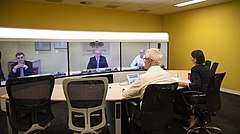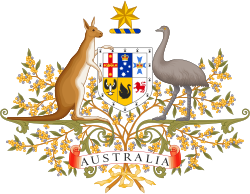National Cabinet (Australia)
The National Cabinet is a special Australian intergovernmental decision-making forum composed of the Prime Minister and the premiers and chief ministers of the states and territories, established on 13 March 2020 to coordinate the national response to the COVID-19 pandemic in Australia.
 National Cabinet meeting on 22 March 2020 | |
| Type | Intergovernmental decision-making forum |
|---|---|
| Participants |
|
| Formed | 13 March 2020 |
 |
|---|
| This article is part of a series on the politics and government of Australia |
| Constitution |
|
On 29 May 2020, the Prime Minister Scott Morrison announced that the National Cabinet would replace the Council of Australian Governments (COAG) and meetings after the pandemic would be held monthly, instead of the biannual meetings of COAG.[1] As part of this transition, Morrison has announced that various supplementary committees will be created within National Cabinet focusing on rural and regional Australia, skills, infrastructure, health, transport, population and migration, and energy.[2]
History and description
The formation of the National Cabinet was announced by Prime Minister Scott Morrison on 13 March 2020,[3] following a meeting of the Council of Australian Governments (COAG).[4] It was created via the "National Partnership on Covid-19 Response" agreement[5] to "coordinate and deliver a consistent national response to COVID-19" during the global COVID-19 pandemic.[6][7][8]
In a "historic first", the New Zealand Prime Minister, Jacinda Ardern, joined a National Cabinet meeting in May 2020 to discuss the economic benefits of trans-Tasman travel between the two nations.[9]
It has been described as akin to Australia's War Cabinet during the Second World War.[10] Meetings of the Cabinet are held using secure video conferencing.[8]
Role and responsibilities
The National Cabinet is responsible for endorsing and coordinating national actions in Australia in response to the coronavirus pandemic. It is advised and supported by the Australian Health Protection Principal Committee (AHPPC),[11] an ongoing body composed of the Chief Medical Officer of the Commonwealth, Brendan Murphy, and the Chief Health Officers of each of the states and territories.[12] The AHPPC uses the currently available modelling, research and data to inform the decisions made by the National Cabinet.[13]
The prime minister said that the National Cabinet has "the status of a cabinet meeting" at a federal level, meaning it has the same confidentiality and Freedom of Information protections as the federal cabinet, under the Freedom of Information Act 1982.[8] The legal authority for much of this structure is based on practice and convention, contained in the official Cabinet Handbook;[14] strictly speaking, based on the Westminster system, cabinet decisions do not of themselves have legal authority. This comes from the Federal Executive Council, which gives legal force to decisions made by the cabinet. "Members of the Cabinet must publicly support all Government decisions made in the Cabinet, even if they do not agree with them. Cabinet ministers cannot dissociate themselves from, or repudiate the decisions of their Cabinet colleagues unless they resign from the Cabinet".[8] The "National Partnership on Covid-19 Response" states in Part 6 (46) that the parties "do not intend any of the provisions of this Agreement to be legally enforceable".[5]
Public policy specialist Jennifer Menzies describes the National Cabinet as "COAG by another name", which has taken on a leadership role during a time of national crisis. She writes "Though called a cabinet, the national cabinet is technically an intergovernmental forum. The conventions and rules of cabinet, such as cabinet solidarity and the secrecy provisions, do not apply to the national cabinet. Its power is that which the leaders of all Australian jurisdictions bring to negotiate on behalf of their people, and to implement the decisions reached. This model is called executive federalism." In this model, the citizens of each state or territory are represented by their elected heads, and the smaller states have equal representation. A forum such as the national cabinet is open to criticism as undemocratic, as the role of the Australian Parliament is put to one side. However, the National Cabinet is based on negotiation and compromise among the states, rather than the will of the majority. Parliament is suspended rather than prorogued (dissolved); Parliament will pass legislation based on decisions made by the National Cabinet. Once the crisis has passed, all decisions taken by the Cabinet will fall under the scrutiny of normal democratic processes and thus be accountable for all decisions taken.[13]
Current membership
| Name | Office held | In office since | Party | |
|---|---|---|---|---|
| Scott Morrison | Prime Minister of Australia (Chair) | 24 August 2018 | Liberal | |
| Gladys Berejiklian | Premier of New South Wales | 23 January 2017 | Liberal | |
| Daniel Andrews | Premier of Victoria | 4 December 2014 | Labor | |
| Annastacia Palaszczuk | Premier of Queensland | 14 February 2015 | Labor | |
| Mark McGowan | Premier of Western Australia | 17 March 2017 | Labor | |
| Steven Marshall | Premier of South Australia | 19 March 2018 | Liberal | |
| Peter Gutwein | Premier of Tasmania | 20 January 2020 | Liberal | |
| Andrew Barr | Chief Minister of the Australian Capital Territory | 11 December 2014 | Labor | |
| Michael Gunner | Chief Minister of the Northern Territory | 31 August 2016 | Labor | |
Meetings and press releases
- 16 March 2020: Announcement of a "significant step-up" to the pandemic, upon the advice of the AHPPC, with additional measures in order to reduce community transmission. These included banning cruise ships from docking, enhanced screening of arrivals, and mandatory self-isolation for everyone arriving in Australia. The Cabinet also activated the second stage of the Australian Health Sector Emergency Response Plan for Novel Coronavirus, which "enables governments to undertake targeted action... and ensures that resources are properly allocated where needed and the risks to vulnerable people in the community are mitigated".[15]
- 25 March 2020: PM announces creation of the National COVID-19 Coordination Commission (NCCC), and clarifies role of various bodies: the National Cabinet "continues to lead the national response at a government level. The National Security Committee of Cabinet's COVID-19 Taskforce and the Expenditure Review Committee of Cabinet continue to take decisions that determine the Commonwealth's response to the global COVID-19 pandemic".[16]
- 29 March 2020: The Cabinet noted that the rate of increase of the spread of COVID-19 was slowing, but overall numbers were still increasing and welcomed the new coronavirus app and WhatsApp channel released by the Government. It announced new limits to indoor and outdoor gatherings to two persons only (with some exceptions); discussed further social distancing measures; gave further advice to senior citizens; and agreed to a moratorium on evictions for the coming six months for both commercial and residential tenancies suffering financial distress.[17]
- 4 May 2020: Jacinda Ardern, the Prime Minister of New Zealand, was invited to join the National Cabinet in a meeting on 5 May, to discuss strategies in dealing with the virus and the Australian COVIDSafe app.[18]
- 29 May 2020: PM announces that the National Cabinet will replace COAG on a permanent basis, meeting monthly once the pandemic is over.[19]
Future
There had been suggestions for the National Cabinet to continue on a permanent basis after the pandemic is over, effectively replacing COAG. On 14 April 2020, Prime Minister Morrison was reported saying, "The processes we've established for the National Cabinet may prove to be a better way for our federal system to work in the future, but this will be a matter for another time", and Western Australian Premier Mark McGowan said no other state leaders had objected when he had brought up the idea of continuing the National Cabinet. He also told The Australian newspaper, "The National Cabinet process has removed the political boundaries that can hamper COAG".[20][21]
Former Labor Premier of South Australia, Jay Weatherill called it a "fantastic innovation [that] should continue", adding that it had "achieved more in the last few months than many COAGs have achieved over many years”.[22]
On 29 May 2020, the Prime Minister announced that the National Cabinet would replace COAG (with COAG being abolished) and meetings after the pandemic would be held monthly, instead of the biannual meetings of COAG.[1] According to Simon Benson of The Australian newspaper, One analogy used to describe the significance of this was "as if the United Nations had been turned into a government".[23]
See also
References
- "COAG scrapped, National Cabinet here to stay, PM says". www.abc.net.au. 29 May 2020. Retrieved 29 May 2020.
- Hitch, Georgia (12 June 2020). "Key moment from the Prime Minister's latest coronavirus press conference after National Cabinet meeting". ABC News. Retrieved 13 June 2020.
- "Advice on coronavirus". Prime Minister of Australia (Press release). 13 March 2020. Retrieved 1 April 2020.
- Martin, Sarah (18 March 2020). "PM tells Australians to 'stop hoarding' as he announces sweeping measures to slow spread of coronavirus". Guardian Australia. Retrieved 1 April 2020.
- National Partnership on Covid-19 Response
- Shoebridge, Michael (18 March 2020). "The national cabinet is key to our coronavirus response. Here's how it will need to work". The Canberra Times. Retrieved 1 April 2020.
- "Press Conference Transcript". Prime Minister's Office. 15 March 2020. Cite journal requires
|journal=(help) - Burton, Tom (18 March 2020). "National cabinet creates a new federal model". Australian Financial Review. Retrieved 30 March 2020.
- "Jacinda Ardern says travel with Australia amid coronavirus pandemic could have 'huge advantages' - ABC News". www.abc.net.au. 4 May 2020. Retrieved 18 May 2020.
- Middleton, Karen (21–27 March 2020). "Inside Morrison's Covid-19 war cabinet". The Saturday Paper (293). Retrieved 1 April 2020.
- "Australian Health Protection Principal Committee (AHPPC)". Australian Government Department of Health. 6 February 2020. Retrieved 31 March 2020.
- "Coronavirus measures endorsed by National Cabinet". Prime Minister of Australia (Press release). Media release. Prime Minister's Office. 16 March 2020. Retrieved 30 March 2020.
- Menzies, Jennifer (31 March 2020). "Explainer: what is the national cabinet and is it democratic?". The Conversation. Retrieved 31 March 2020.
CC BY-ND 4.0
- Commonwealth of Australia. Department of the Prime Minister and Cabinet, (2019). Cabinet Handbook (PDF) (13th ed.). ISBN 978-1-925364-00-2. Retrieved 30 March 2020.
CC BY 4.0
CS1 maint: extra punctuation (link) - "Coronavirus measures endorsed by National Cabinet". Prime Minister of Australia. Retrieved 1 April 2020.
- "National Covid-19 Coordination Commission". Prime Minister of Australia (Press release). 25 March 2020. Retrieved 1 April 2020.
- "National Cabinet Statement". Prime Minister of Australia (Press release). 29 March 2020. Retrieved 30 March 2020.
- Murphy, Katharine (4 May 2020). "Jacinda Ardern joins national cabinet meeting as Australia, New Zealand share coronavirus strategy". the Guardian. Retrieved 4 May 2020.
- "Update following National Cabinet meeting". Prime Minister of Australia. Retrieved 29 May 2020.
- "COVID-19 crisis cabinet to outlive pandemic and replace COAG". The Australian. 14 April 2020. Retrieved 14 April 2020.
- "Scott Morrison considers making National Cabinet permanent". SBS News. 14 April 2020. Retrieved 14 April 2020.
- Richardson, Tom (6 May 2020). "Retain national cabinet post-pandemic: ex-Premier". InDaily. Retrieved 6 May 2020.
- Benson, Simon (29 May 2020). "Coronavirus: All parties eager to sign up for a new national forum". The Australian. Retrieved 30 May 2020.
Further reading
- Saunders, Cheryl (14 April 2020). COVID-19: What is Australia's National Cabinet? [Law and Covid-19: Australia's National Cabinet. YouTube. University of Melbourne. Melbourne Law School. (5 mins 50 secs)
- Saunders, Cheryl (1 July 2020). "A New Federalism? The Role and Future of the National Cabinet" (PDF). University of Melbourne.